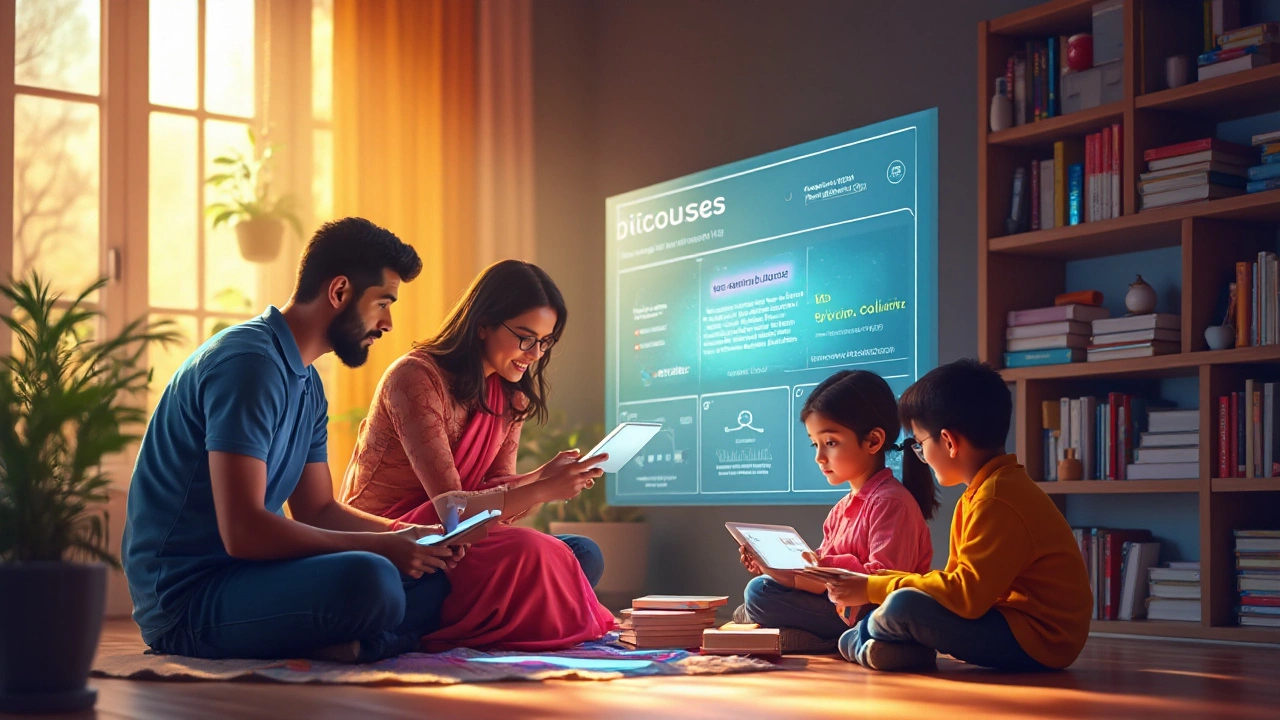
In a world increasingly dependent on technology, education has not been left behind. The shift towards online learning platforms has transformed the way we acquire knowledge, providing flexibility and accessibility that traditional methods can't always offer.
This digital revolution in education has led to the rise of numerous e-learning applications, each offering unique features and tailored experiences to cater to diverse learning needs. But with so many options available, which app takes the crown in 2025 as the top learning tool?
In this article, we dive into the fast-evolving landscape of e-learning apps. We'll discuss what makes these platforms tick, highlight some leading contenders, and uncover the secrets behind the most effective digital educational tools available today.
- The Rise of E-Learning Apps
- Criteria for Choosing the Best App
- Top Contenders in E-Learning
- Unique Features of Winning Apps
- Making the Most of E-Learning
The Rise of E-Learning Apps
The journey of digital education has been nothing short of extraordinary, transforming the traditional classroom experience into a dynamic, online environment that offers a wealth of possibilities. The advent of e-learning platforms has revolutionized how people across the globe access knowledge. Initially adopted as supplementary educational tools, these learning apps have evolved into full-fledged virtual classrooms that thrive on the accessibility and flexibility they provide. By 2025, the reach of digital education has expanded manifold, breaking barriers of location, language, and even financial constraints. It’s no wonder that statistics show a significant increase in global e-learning market size, projected to be worth $375 billion by 2026, with millions of users enjoying these educational tools daily.
The driving force behind this revolution is the rapid advancement of technology, coupled with a growing acceptance of online education as a legitimate form of learning. Smartphones, tablets, and high-speed internet have become ubiquitous, making education technology more accessible to students worldwide. This digital transformation is further fueled by changes in societal needs and professional landscapes, which demand continual learning and upskilling. More than ever, individuals from varied backgrounds see e-learning as an opportunity to expand their knowledge repertoire and keep up with evolving job markets.
Interestingly, the rise of e-learning coincides with a cultural shift towards lifelong learning. People are increasingly motivated to learn new skills or delve into different fields throughout their lives. E-learning platforms cater perfectly to this aspiration, providing bite-sized, engaging content that fits seamlessly into busy schedules. According to a study by HolonIQ, microlearning has become one of the fastest-growing educational trends, allowing users to learn efficiently without disrupting their everyday lives.
"The beauty of mobile learning is that it literally places the world--and access to knowledge--at our fingertips," says David Price OBE, an expert in learning futuristics. "It's not just about convenience; it's about reaching people who never had the opportunity before."
This shift towards digital learning also embodies significant innovations in educational methodologies. Interactive features, gamification, virtual reality, and artificial intelligence are just a few examples of how tech enhancements make e-learning more appealing and effective. This way, students not only absorb information but also actively interact with it, making the learning process more impactful and engaging. Educational apps provide analytics and insights into the learner's performance, offering personalized pathways to suit individual learning curves.
On the back of these developments, the landscape of e-learning apps has become competitive, with numerous players vying to offer the best in terms of content quality, user experience, and innovation. This competition encourages continuous improvement and evolution, benefiting learners by providing them with the latest, most effective educational tools. As we look towards the future, the role of learning apps will likely continue to grow, shaping the education of tomorrow and ensuring that learning is an enriching endeavor for everyone, regardless of age or background.
Criteria for Choosing the Best App
Choosing a learning app that suits your needs can seem overwhelming, given the vast array of options available. However, starting with clear criteria can help make this decision less daunting and far more manageable. To begin with, consider what you are aiming to achieve. Are you looking to master a new language, improve your coding skills, or are you interested in a wide breadth of subjects? Identifying your goal is the first crucial step to narrowing down your choices. This focus will prevent you from getting lost in the sea of e-learning platforms.
Another significant consideration is the app's learning methodology. Different apps employ different styles – some may offer video lectures, others provide interactive quizzes, while others might focus on gamified learning experiences. Research has shown that interactive learning, which encourages active participation, is often more effective than passive watching. According to a recent study by the e-Learning Guild, learners who engage interactively can recall more concepts over a longer period.
"The best learning experiences come from platforms that adapt to the individual needs of the user," said Dr. James Mulford from the University of Digital Education. "It's all about customizing the learning journey based on personal strengths and weaknesses."In line with Dr. Mulford's insights, personalization is another key criterion for selecting a top e-learning application. Adaptive learning technologies allow apps to tailor their content to the individual user's pace and level of understanding, which can significantly enhance the learning experience.
Evaluating the user experience (UX) of the app is also vital. An app might have excellent content, but if it's poorly organized or difficult to navigate, students might lose interest quickly. Look for features like intuitive design, offline functionality, and customer support, all of which play significant roles in user satisfaction. A study conducted found that 76% of users stop using an app after poor experiences, highlighting the importance of a seamless interface.
Moreover, consider the education technology underlying the app. Advanced technology like AI-driven insights can offer predictive analytics to guide your learning paths. These insights can provide recommendations on which topics to review or focus more on, enhancing your learning effectiveness. Also, check whether the app offers progress tracking, which not only helps maintain motivation but also allows learners to see measurable improvements over time.
Finally, take into account community and peer interaction. Some apps integrate forums or group activities to foster a sense of community learning. This can be invaluable for building networks or finding study partners, especially when learning new concepts or tackling difficult assignments.

Top Contenders in E-Learning
The digital age has brought us a variety of learning apps designed to cater to diverse educational needs. Whether you're diving into coding, picking up a new language, or exploring creative skills, there's something for everyone. In 2025, some apps have truly set themselves apart as leaders in the e-learning domain.
At the forefront is Duolingo, renowned for its user-friendly approach to language learning. Its gamified style allows users to earn points, unlock new levels, and preserve their streaks. This method resonates with many beginners and intermediates who've found traditional lessons cumbersome. According to a 2023 survey, Duolingo had over 500 million downloads, underscoring its immense popularity and effectiveness in making language learning engaging and accessible.
Khan Academy is another titan in this space, focusing on providing free, world-class education to anyone, anywhere. It offers a comprehensive range of subjects from early childhood education to high school topics, even venturing into standardized test preparations. A standout feature is its personalized dashboard, which allows learners to study at their own pace. Khan Academy's philosophy is best captured in founder Salman Khan's words:
"You only have to know one thing: You can learn anything."
Coursera, a platform offering courses from leading universities and companies, has made waves by bridging the gap between academia and professional skills. Its collaborations with institutions like Yale and companies like Google have resulted in courses that validate skills applicable in today's job market. The mix of free courses and purchasable certifications makes it a cost-effective tool for lifelong learners looking to bolster their resumes.
These platforms are not just about content delivery; they prioritize user experience, community interaction, and adaptive learning. While other contenders like edX and Skillshare have their strengths, these three have consistently received praise for balancing quality education with convenience. What's vital is that these e-learning tools democratize education, giving anyone with internet access an opportunity to expand their horizons.
Statistics show that people using e-learning apps can complete courses up to 60% faster compared to traditional classroom settings. This effectiveness is rooted in their ability to deliver content in digestible pieces, making learning flexible. As we continue to embrace digital learning, these top contenders set a high bar, pushing others to innovate and improve, all while making learning a delightful journey.
Unique Features of Winning Apps
When diving into the expansive world of learning apps, the standout features that characterize winning applications cannot be ignored. The most successful platforms offer a fusion of innovative technology, engaging content, and adaptability that caters to a spectrum of learning styles and preferences. Each feature is a strategic answer to the expectations and demands of the modern learner who is juggling multiple responsibilities, seeks personalized experiences, and craves engaging, interactive ways to gain new skills.
One prominent feature of top e-learning platforms is the use of artificial intelligence to personalize the learning journey. These apps cleverly analyze user behavior and adapt content delivery to better match the learning pace and style of individual users. For instance, applications like Duolingo and Coursera utilize machine learning algorithms that suggest courses, quizzes, or lessons tailored to the user's performance, ensuring that learning is neither too challenging nor too simplistic, which sustains motivation over extended periods.
Another compelling characteristic of top-tier e-learning apps is the integration of interactive multimedia resources. Visual elements like video tutorials, infographics, and interactive simulations are increasingly popular because they enhance engagement and retention among users. Platforms like Khan Academy offer a plethora of video lectures combined with practical exercises that empower learners to apply knowledge in real-time. This type of immersive content gives depth to the learning experience, making complex concepts more digestible and relatable.
The winning apps are also highly accessible, embracing the necessity of learning on-the-go. Mobile-friendly interfaces ensure that users can seamlessly transition from desktops to smartphones or tablets without disrupting the learning process. The LinkedIn Learning app, for instance, showcases a mobile version that ensures users can continue watching lessons or participating in quizzes even while offline, thus acknowledging and accommodating the unpredictable lifestyles of today's learners.
"The future of education is in creating a strategic alliance between technology and pedagogy," says John T. Chambers. "It’s not just about access, but about engagement and efficiency."
Social learning, or the incorporation of social media-inspired features, is another area where leading applications shine. By allowing users to connect with peers, share achievements, and collaborate on projects, platforms leverage community power to enhance motivation and accountability. This facet is particularly effective in language learning apps like Babbel, where learners can practice with real people, enhancing fluency and confidence through interaction rather than isolated study.
The measurement and tracking of progress also feature prominently in the arsenal of a successful education technology app. Detailed analytics and reports on learning progress provide valuable insights for both student and teacher. Apps like Google Classroom and Blackboard Learn offer dashboards that visualize progression and pinpoint areas needing improvement, enabling focused and efficient learning strategies.
| Top Features | Description |
|---|---|
| Personalization | AI-driven content tailored to individual learning paths |
| Interactive Multimedia | Rich, engaging content types like videos and simulations |
| Mobile Access | Consistent learning experience across multiple devices |
| Social Learning | Peer interaction and collaboration to boost engagement |
| Progress Tracking | Analytics and reports for insightful learning feedback |
In essence, the indistinct line between technology and pedagogy is where the magic of learning apps lies. These unique features are the catalytic forces that propel users forward in their educational journeys, expertly combined to navigate the dynamic, ever-evolving landscape of e-learning. The best app for one may not be the best for all, but with such a variety of intuitive features available, each learner is sure to find their ideal digital study partner.

Making the Most of E-Learning
To truly harness the potential of e-learning apps, it's essential to approach them strategically. E-learning offers an unprecedented opportunity to tailor education to individual needs and preferences, making learning more personalised than ever before. Before diving into an online course, it's crucial to establish a structured plan. Begin by identifying your learning objectives—whether it's mastering a new language, gaining new skills for a career shift, or deepening an understanding of a particular subject. Setting achievable goals not only clarifies what you hope to achieve but also helps in selecting the most suitable courses or learning apps.
Commitment is key in online learning. Create a realistic study schedule, allocating specific days and times for learning activities. Consistency ensures steady progress; even short daily learning bursts can be more effective than sporadic long sessions. While online platforms offer self-paced courses, it’s beneficial to set deadlines for completion to maintain motivation. Engage with the learning community if the app provides forums or discussion groups. Interaction with fellow learners can boost encouragement and provide insight into real-world applications of what you're learning.
"Education is not the filling of a pot but the lighting of a fire." - W.B. Yeats
Taking notes while learning can significantly enhance knowledge retention. Instead of simply reading or listening, jot down key points in your own words. Consider using digital tools or apps that integrate with your e-learning platform for a seamless experience. Testing your knowledge is another effective strategy. Most learning apps offer quizzes and assessments; make the most of these tools to reinforce what you've learned and identify areas needing improvement. Don't hesitate to revisit and review previous modules to solidify your understanding.
Balancing screen time with physical and mental breaks can help maintain focus. As much as these platforms use engaging media, prolonged screen use can lead to fatigue. Schedule breaks, using them as a reward system for achieving learning milestones. Furthermore, with the plethora of apps available, continually evaluate your chosen platform’s effectiveness. Are you meeting your learning goals? Does your current platform align with your preferred learning style? Remember, the beauty of online learning lies in choice and customization.
If you're interested in data, some e-learning platforms provide analytics showing patterns in your learning habits. This feedback can highlight strengths and reveal areas of improvement, offering a clearer path forward. Below is an example of how you might visualize your learning progress:
| Week | Hours Spent | Modules Completed |
|---|---|---|
| 1 | 10 | 3 |
| 2 | 12 | 4 |
In the fast-paced digital age, the desire to keep learning is crucial. By leveraging the right tools and approaches within e-learning platforms, not only can you acquire valuable knowledge and skills, but you can also shape a lifelong learning habit that matches the rhythm of your life in 2025 and beyond.





